trailer Peugeot 508 Hybrid 2014 Owner's Manual
[x] Cancel search | Manufacturer: PEUGEOT, Model Year: 2014, Model line: 508 Hybrid, Model: Peugeot 508 Hybrid 2014Pages: 380, PDF Size: 10.94 MB
Page 5 of 380
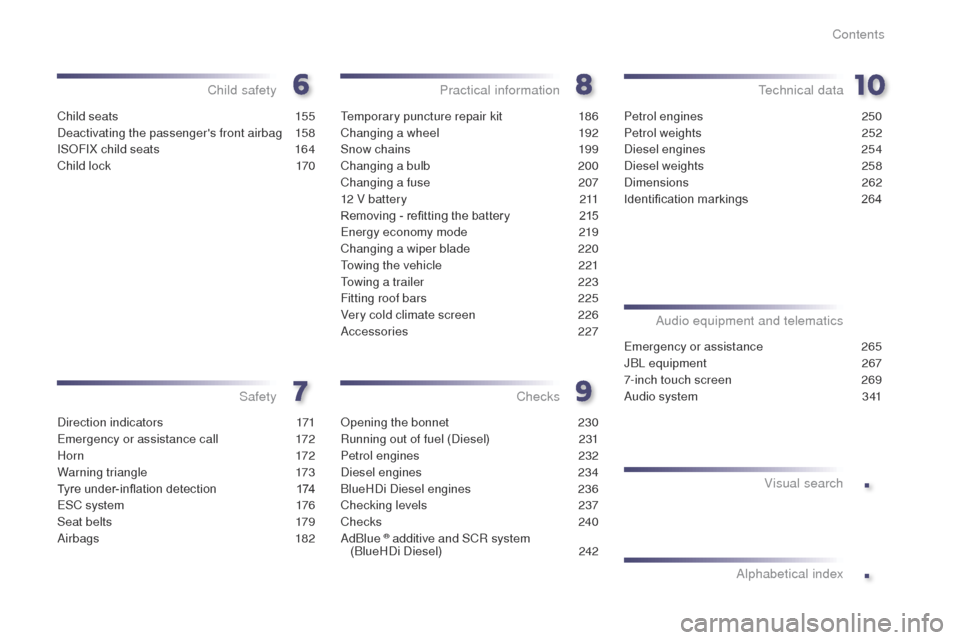
.
.
508_en_Chap00a_sommaire_ed02-2014
Child seats 155
Deactivating the passenger's front airbag
1
58
ISOFIX child seats
1
64
Child lock
1
70
Child safety
Direction indicators 1 71
em
ergency or assistance call
1
72
H o r n
172
Warning triangle
1
73
Tyre under-inflation detection
1
74
e
SC system
1
76
Seat belts
1
79
Airbags
1
82
Safety
temporary puncture repair kit 186
Changing a wheel
1
92
Snow chains
1
99
Changing a bulb
2
00
Changing a fuse
2
07
12 V battery
2
11
Removing - refitting the battery
2
15
en
ergy economy mode
2
19
Changing a wiper blade
2
20
to
wing the vehicle
2
21
to
wing a trailer
2
23
Fitting roof bars
2
25
Very cold climate screen
2
26
Accessories
227
Practical information
Opening the bonnet 2 30
Running out of fuel (Diesel)
2
31
Petrol engines
2
32
Diesel engines
2
34
BlueHDi Diesel engines
2
36
Checking levels
23
7
Checks
240
AdBlue
® additive and SCR system
(BlueHDi Diesel) 2 42
Checks
Petrol engines 2 50
Petrol weights
2
52
Diesel engines
2
54
Diesel weights
2
58
Dimensions
262
Identification markings
2
64
technical data
emergency or assistance 2 65
JBL equipment
2
67
7-inch touch screen
2
69
Audio system
3
41
Audio equipment and telematics
Alphabetical indexVisual search
Contents
Page 13 of 380
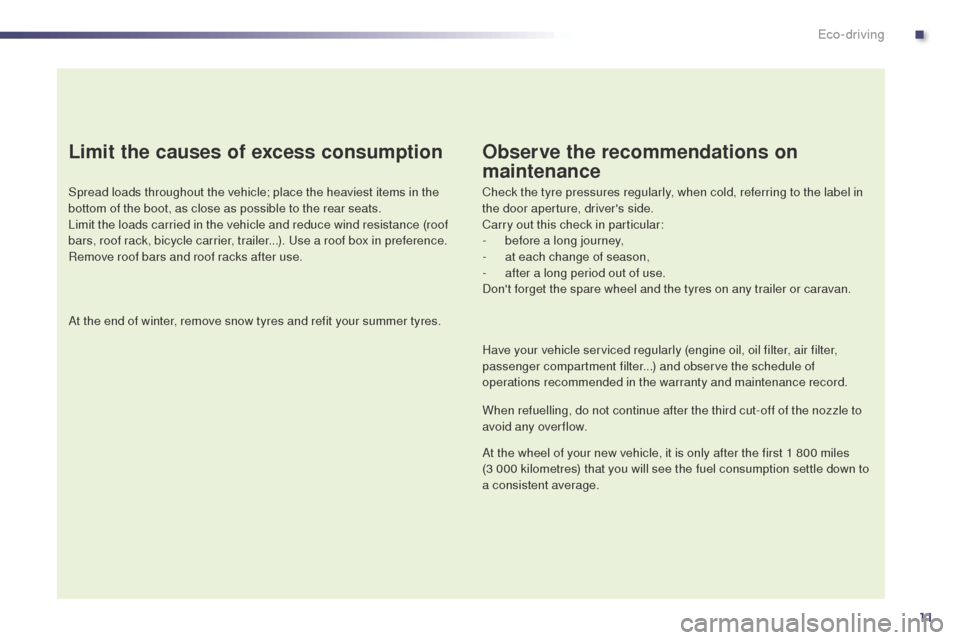
11
Limit the causes of excess consumption
Spread loads throughout the vehicle; place the heaviest items in the
bottom of the boot, as close as possible to the rear seats.
Limit the loads carried in the vehicle and reduce wind resistance (roof
bars, roof rack, bicycle carrier, trailer...). u
s
e a roof box in preference.
Remove roof bars and roof racks after use.
At the end of winter, remove snow tyres and refit your summer tyres.
Observe the recommendations on
maintenance
Check the tyre pressures regularly, when cold, referring to the label in
the door aperture, driver's side.
Carry out this check in particular:
-
b
efore a long journey,
-
a
t each change of season,
-
a
fter a long period out of use.
Don't forget the spare wheel and the tyres on any trailer or caravan.
Have your vehicle serviced regularly (engine oil, oil filter, air filter,
passenger compartment filter...) and observe the schedule of
operations recommended in the warranty and maintenance record.
When refuelling, do not continue after the third cut-off of the nozzle to
avoid any over flow.
At the wheel of your new vehicle, it is only after the first 1 800 miles
(3 000 kilometres) that you will see the fuel consumption settle down to
a consistent average.
.
Eco-driving
Page 106 of 380
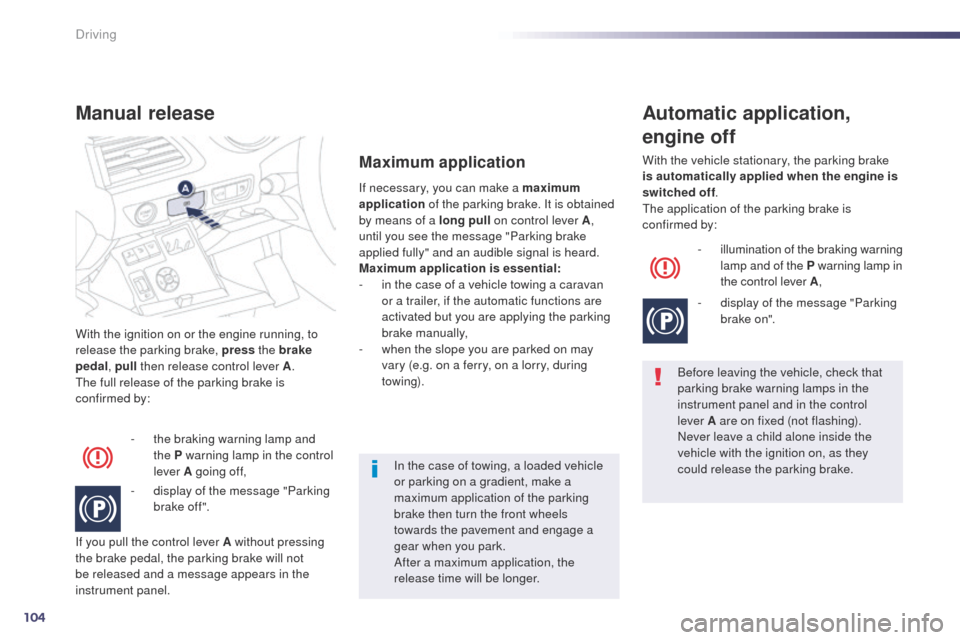
104
With the ignition on or the engine running, to
release the parking brake, press the brake
pedal , pull then release control lever A .
th
e full release of the parking brake is
confirmed by:
Manual release
- the braking warning lamp and the P warning lamp in the control
lever A going of f,
-
d
isplay of the message "Parking
brake of f ".
If you pull the control lever A without pressing
the brake pedal, the parking brake will not
be released and a message appears in the
instrument panel. If necessary, you can make a maximum
application
of the parking brake. It is obtained
by means of a long pull on control lever A,
until you see the message "Parking brake
applied fully" and an audible signal is heard.
Maximum application is essential:
-
i
n the case of a vehicle towing a caravan
or a trailer, if the automatic functions are
activated but you are applying the parking
brake manually,
-
w
hen the slope you are parked on may
vary (e.g. on a ferry, on a lorry, during
towing).
Maximum application
Before leaving the vehicle, check that
parking brake warning lamps in the
instrument panel and in the control
lever A are on fixed (not flashing).
Never leave a child alone inside the
vehicle with the ignition on, as they
could release the parking brake.
Automatic application,
engine off
- illumination of the braking warning lamp and of the P warning lamp in
the control lever A ,
-
d
isplay of the message "Parking
brake on".
With the vehicle stationary, the parking brake
is automatically applied when the engine is
switched off
.
th
e application of the parking brake is
confirmed by:
In the case of towing, a loaded vehicle
or parking on a gradient, make a
maximum application of the parking
brake then turn the front wheels
towards the pavement and engage a
gear when you park.
After a maximum application, the
release time will be longer.
Driving
Page 129 of 380
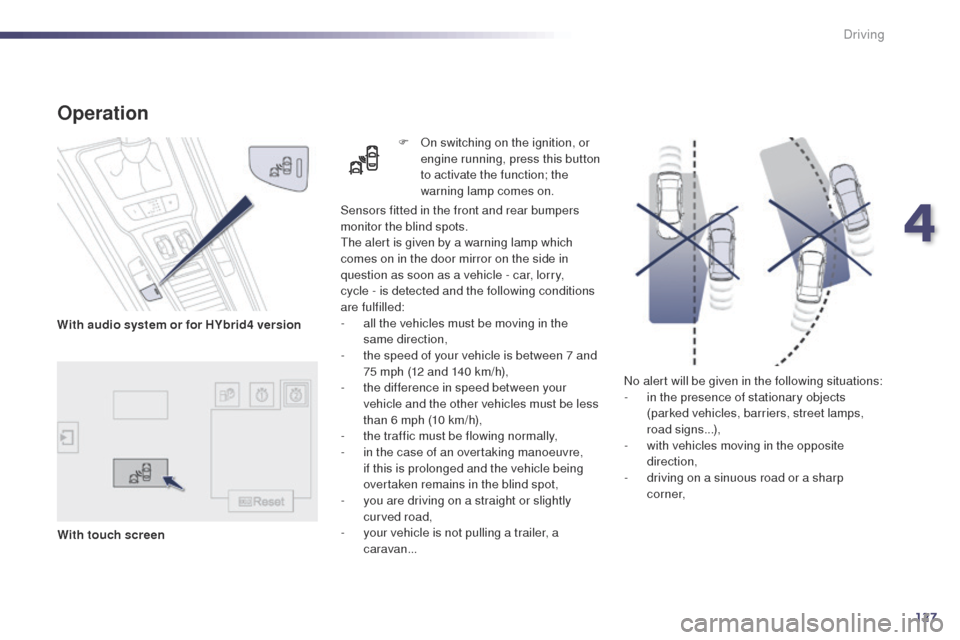
127
No alert will be given in the following situations:
- i n the presence of stationary objects
(parked vehicles, barriers, street lamps,
road signs...),
-
w
ith vehicles moving in the opposite
direction,
-
d
riving on a sinuous road or a sharp
c o r n e r,
Sensors fitted in the front and rear bumpers
monitor the blind spots.
th
e alert is given by a warning lamp which
comes on in the door mirror on the side in
question as soon as a vehicle - car, lorry,
cycle
- is detected and the following conditions
are fulfilled:
-
a
ll the vehicles must be moving in the
same direction,
-
t
he speed of your vehicle is between 7 and
75 mph (12 and 140 km/h),
-
t
he difference in speed between your
vehicle and the other vehicles must be less
than 6 mph (10 km/h),
-
t
he traffic must be flowing normally,
-
i
n the case of an overtaking manoeuvre,
if this is prolonged and the vehicle being
overtaken remains in the blind spot,
-
y
ou are driving on a straight or slightly
curved road,
-
y
our vehicle is not pulling a trailer, a
caravan...
Operation
F On switching on the ignition, or engine running, press this button
to activate the function; the
warning lamp comes on.
With audio system or for HYbrid4 version
With touch screen
4
Driving
Page 137 of 380
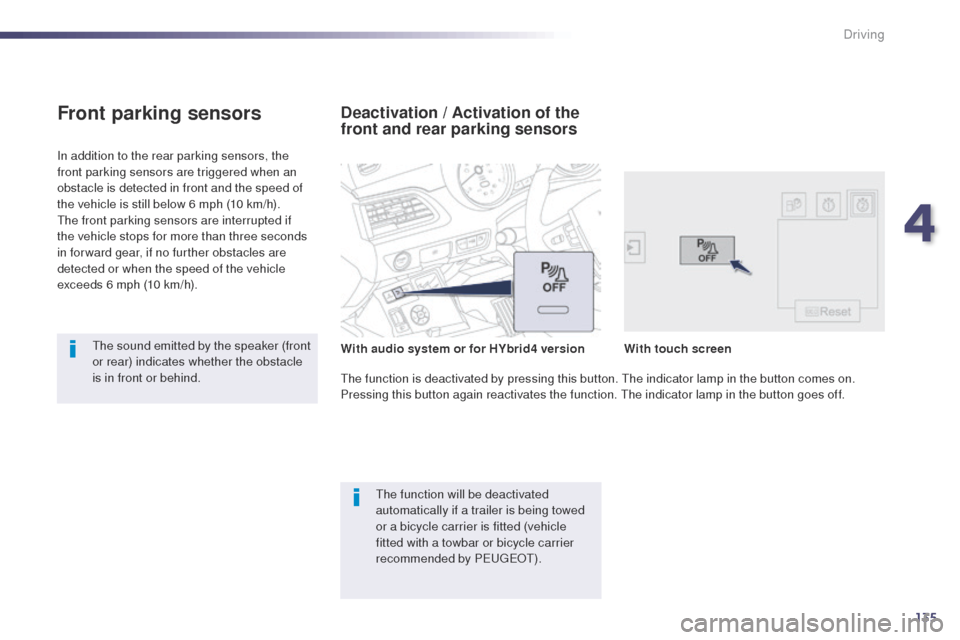
135
In addition to the rear parking sensors, the
front parking sensors are triggered when an
obstacle is detected in front and the speed of
the vehicle is still below 6 mph (10 km/h).
th
e front parking sensors are interrupted if
the vehicle stops for more than three seconds
in for ward gear, if no further obstacles are
detected or when the speed of the vehicle
exceeds 6 mph (10 km/h).
Front parking sensors
the function will be deactivated
automatically if a trailer is being towed
or a bicycle carrier is fitted (vehicle
fitted with a towbar or bicycle carrier
recommended by P
e
uge
Ot)
.
Deactivation / Activation of the
front and rear parking sensors
the function is deactivated by pressing this button. th e indicator lamp in the button comes on.
Pressing this button again reactivates the function. th e indicator lamp in the button goes off.
th
e sound emitted by the speaker (front
or rear) indicates whether the obstacle
is in front or behind. With
audio system or for HYbrid4 version With
touch screen
4
Driving
Page 225 of 380
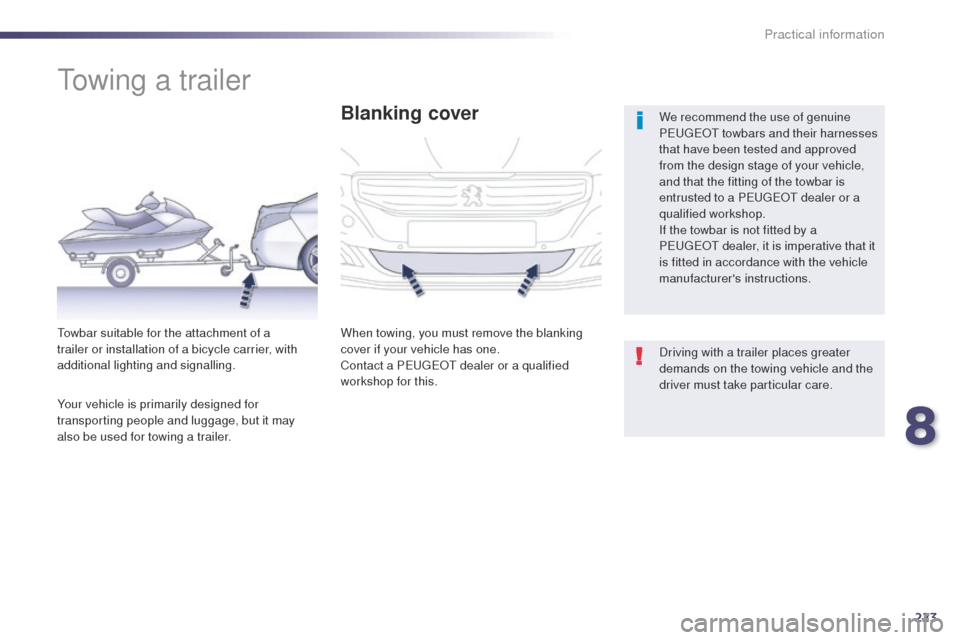
223
508_en_Chap08_info-pratiques_ed02-2014
towing a trailer
We recommend the use of genuine
PeugeOt towbars and their harnesses
that have been tested and approved
from the design stage of your vehicle,
and that the fitting of the towbar is
entrusted to a P
e
uge
Ot
dealer or a
qualified workshop.
If the towbar is not fitted by a
P
e
uge
Ot
dealer, it is imperative that it
is fitted in accordance with the vehicle
manufacturer's instructions.
to
wbar suitable for the attachment of a
trailer or installation of a bicycle carrier, with
additional lighting and signalling.Blanking cover
When towing, you must remove the blanking
cover if your vehicle has one.
Contact a P
e
uge
Ot
dealer or a qualified
workshop for this. Driving with a trailer places greater
demands on the towing vehicle and the
driver must take particular care.
Your vehicle is primarily designed for
transporting people and luggage, but it may
also be used for towing a trailer.
8
Practical information
Page 226 of 380
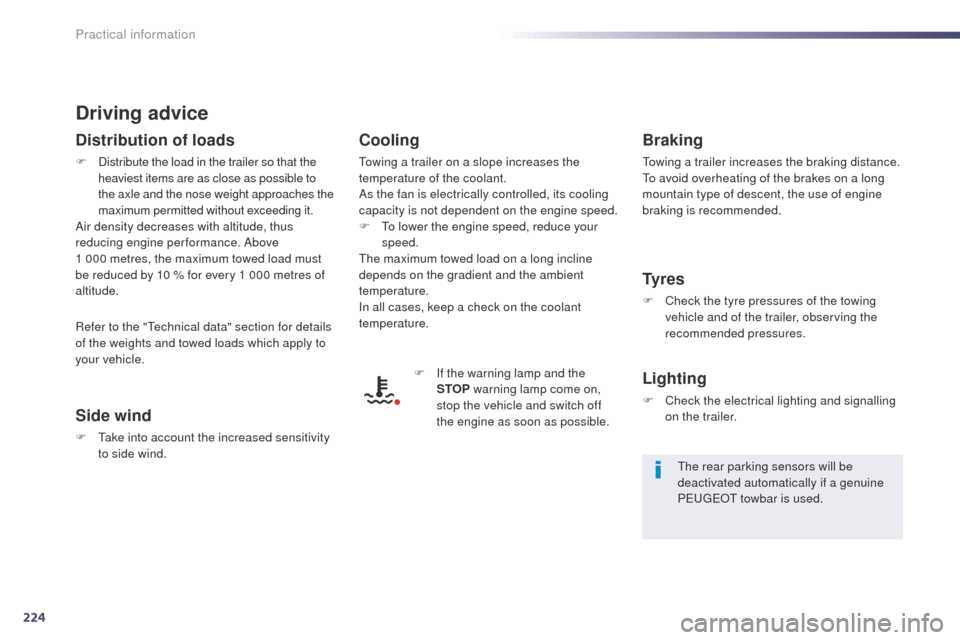
224
508_en_Chap08_info-pratiques_ed02-2014
Driving advice
Distribution of loads
F Distribute the load in the trailer so that the heaviest items are as close as possible to
the axle and the nose weight approaches the
maximum permitted without exceeding it.
Air density decreases with altitude, thus
reducing engine performance. Above
1
000 metres, the maximum towed load must
be reduced by 10
% for every 1 000 metres of
altitude.
Side wind
F take into account the increased sensitivity to side wind.
Cooling
towing a trailer on a slope increases the
temperature of the coolant.
As the fan is electrically controlled, its cooling
capacity is not dependent on the engine speed.
F
t
o l
ower the engine speed, reduce your
speed.
th
e maximum towed load on a long incline
depends on the gradient and the ambient
temperature.
In all cases, keep a check on the coolant
temperature.
F
I
f the warning lamp and the
STOP warning lamp come on,
stop the vehicle and switch off
the engine as soon as possible.
Braking
towing a trailer increases the braking distance.to a void overheating of the brakes on a long
mountain type of descent, the use of engine
braking is recommended.
Ty r e s
F Check the tyre pressures of the towing vehicle and of the trailer, observing the
recommended pressures.
Lighting
F Check the electrical lighting and signalling on the trailer.
th
e rear parking sensors will be
deactivated automatically if a genuine
P
e
uge
Ot
towbar is used.
Refer to the "
te
chnical data" section for details
of the weights and towed loads which apply to
your vehicle.
Practical information
Page 229 of 380
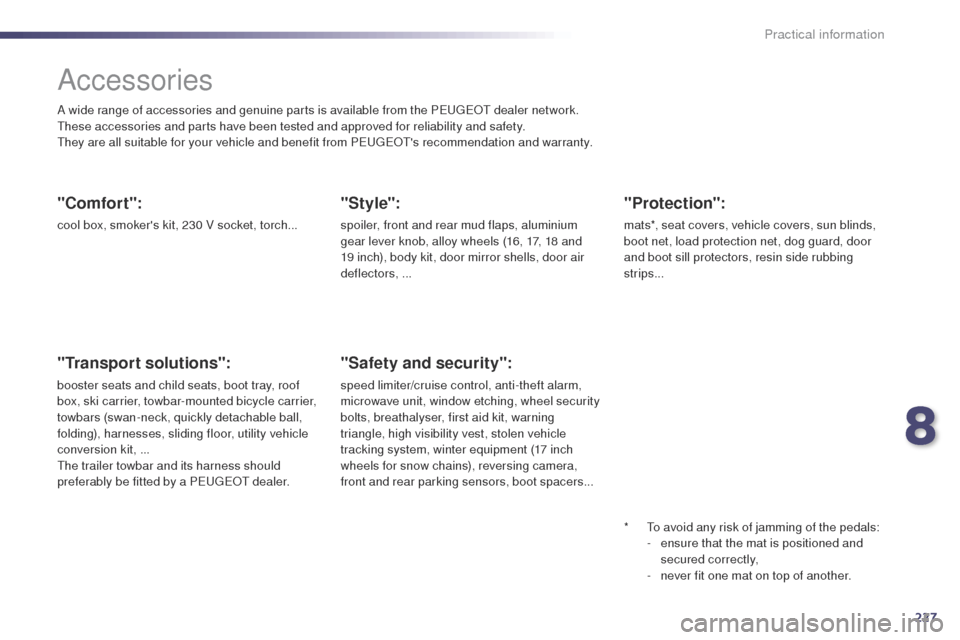
227
508_en_Chap08_info-pratiques_ed02-2014
Accessories
A wide range of accessories and genuine parts is available from the PeugeOt dealer network.th
ese accessories and parts have been tested and approved for reliability and safety.
th
ey are all suitable for your vehicle and benefit from P
e
uge
Ot'
s recommendation and warranty.
"Comfort":
cool box, smoker's kit, 230 V socket, torch...
"Transport solutions":
booster seats and child seats, boot tray, roof
box, ski carrier, towbar-mounted bicycle carrier,
towbars (swan-neck, quickly detachable ball,
folding), harnesses, sliding floor, utility vehicle
conversion kit, ...
th
e trailer towbar and its harness should
preferably be fitted by a P
e
uge
Ot
dealer.
"Style":
spoiler, front and rear mud flaps, aluminium
gear lever knob, alloy wheels (16, 17, 18 and
19 inch), body kit, door mirror shells, door air
deflectors, ...
*
t
o a
void any risk of jamming of the pedals:
-
e
nsure that the mat is positioned and
secured correctly,
-
n
ever fit one mat on top of another.
"Safety and security":
speed limiter/cruise control, anti-theft alarm,
microwave unit, window etching, wheel security
bolts, breathalyser, first aid kit, warning
triangle, high visibility vest, stolen vehicle
tracking system, winter equipment (17 inch
wheels for snow chains), reversing camera,
front and rear parking sensors, boot spacers...
"Protection":
mats*, seat covers, vehicle covers, sun blinds,
boot net, load protection net, dog guard, door
and boot sill protectors, resin side rubbing
strips...
8
Practical information
Page 254 of 380
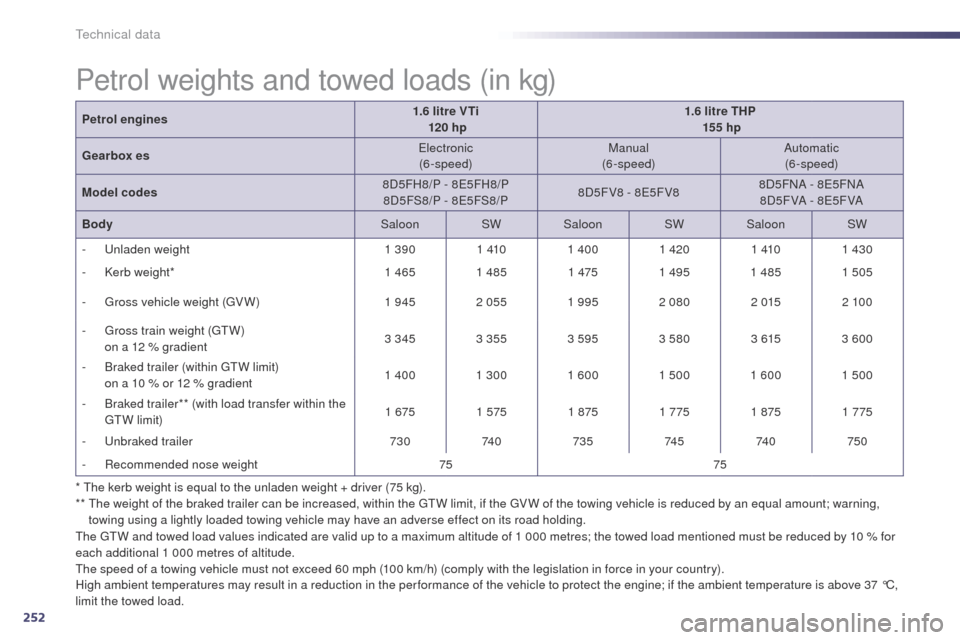
252
508_en_Chap10_caracteristiques-techniques_ed02-2014
* the kerb weight is equal to the unladen weight + driver (75 kg).
** th e weight of the braked trailer can be increased, within the gtW l imit, if the gV W of the towing vehicle is reduced by an equal amount; warning,
towing using a lightly loaded towing vehicle may have an adverse effect on its road holding.
Petrol weights and towed loads (in kg)
the gtW a nd towed load values indicated are valid up to a maximum altitude of 1 000 metres; the towed load mentioned must be reduced by 10 % for
each additional 1 000 metres of altitude.
th
e speed of a towing vehicle must not exceed 60 mph (100 km/h) (comply with the legislation in force in your country).
High ambient temperatures may result in a reduction in the per formance of the vehicle to protect the engine; if the ambient temperature is above 37 °C,
limit the towed load. Petrol engines
1.6 litre VTi
120 hp 1.6 litre THP
155 hp
Gearbox es
ele
ctronic
(6-speed) Manual
(6-speed) Automatic
(6-speed)
Model codes 8D5FH8/P - 8
e5
FH8/P
8D5FS8/P - 8
e5F
S8/P
8D5FV8 - 8
e5
FV8
8D5FNA - 8
e5
FNA
8 D5 F VA - 8
e5
F VA
Body SaloonSWSaloon SWSaloon SW
- u
n
laden weight
1 3901 4101 400 1 420 1 4101 430
-
K
erb weight*
1 4651 485 1 4751 495 1 485 1 505
- g
r
oss vehicle weight (
gV
W)
1 9452 0551 995 2 080 2 0152 10 0
- g
r
oss train weight (
g
t
W
)
o
n a 12 % gradient
3 345
3 3553 5953 580 3 6153 600
-
B
raked trailer (within gt
W l
imit)
o
n a 10 % or 12 % gradient
1 400 1 300 1 600 1 500 1 600 1 500
-
B
raked trailer** (with load transfer within the
g
t
W
limit)
1 675
1 575 1 8751 775 1 8751 775
-
u
nb
raked trailer
73074 0735 74 574 0750
-
R
ecommended nose weight
7575
technical data
Page 255 of 380
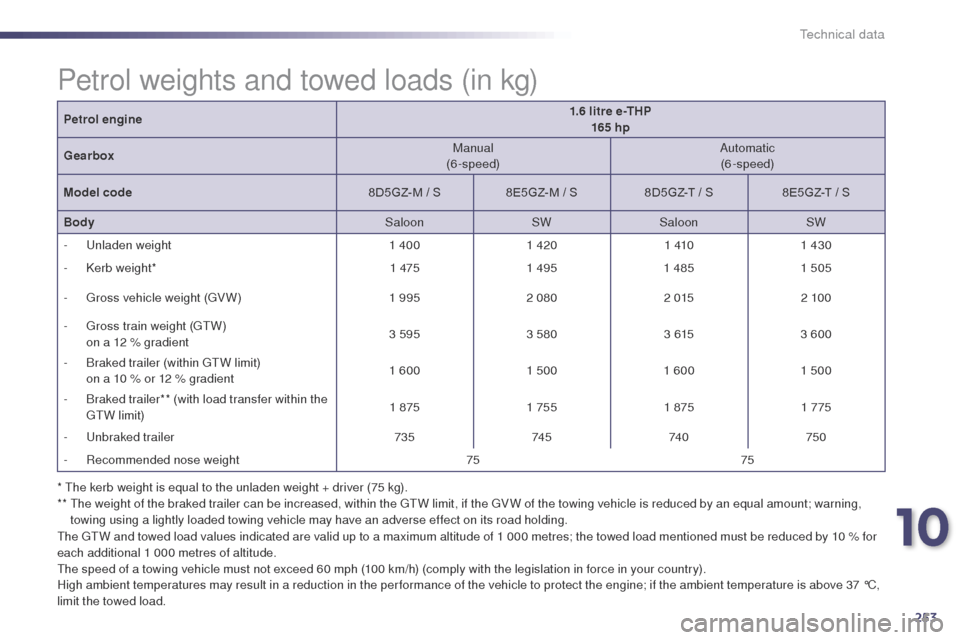
253
508_en_Chap10_caracteristiques-techniques_ed02-2014
Petrol engine1.6 litre e-THP
165 hp
Gearbox Manual
(6-speed) Automatic
(6-speed)
Model code 8D5GZ-M / S8E5GZ-M / S 8D5GZ-T / S8E5GZ-T / S
Body SaloonSWSaloon SW
-
u
n
laden weight 1 4001 420 1 4101 430
-
K
erb weight* 1 4751 495 1 4851 505
-
g
r
oss vehicle weight (
gV
W) 1 9952 080 2 0152 10 0
-
g
r
oss train weight (
g
t
W
)
o
n a 12 % gradient 3 595
3 580 3 6153 600
-
B
raked trailer (within gt
W l
imit)
o
n a 10 % or 12 % gradient 1 600
1 5001 600 1 500
-
B
raked trailer** (with load transfer within the
g
t
W
limit) 1 875
1 755 1 8751 775
-
u
nb
raked trailer 73574 574 0750
-
R
ecommended nose weight 7575
*
t
h
e kerb weight is equal to the unladen weight + driver (75 kg).
**
t
h
e weight of the braked trailer can be increased, within the gt
W l
imit, if the g
V
W of the towing vehicle is reduced by an equal amount; warning,
towing using a lightly loaded towing vehicle may have an adverse effect on its road holding.
Petrol weights and towed loads (in kg)
the gtW a nd towed load values indicated are valid up to a maximum altitude of 1 000 metres; the towed load mentioned must be reduced by 10 % for
each additional 1 000 metres of altitude.
th
e speed of a towing vehicle must not exceed 60 mph (100 km/h) (comply with the legislation in force in your country).
High ambient temperatures may result in a reduction in the per formance of the vehicle to protect the engine; if the ambient temperature is above 37 °C,
limit the towed load.
10
technical data